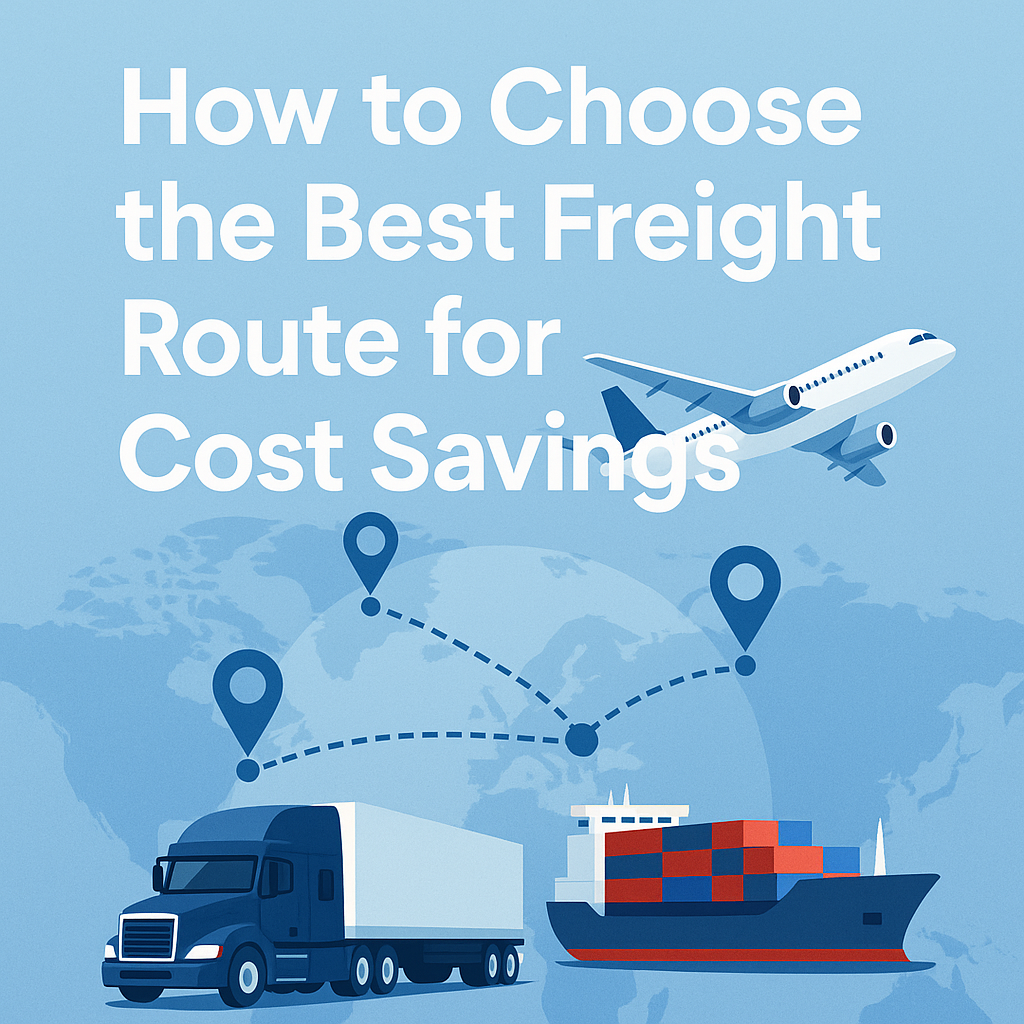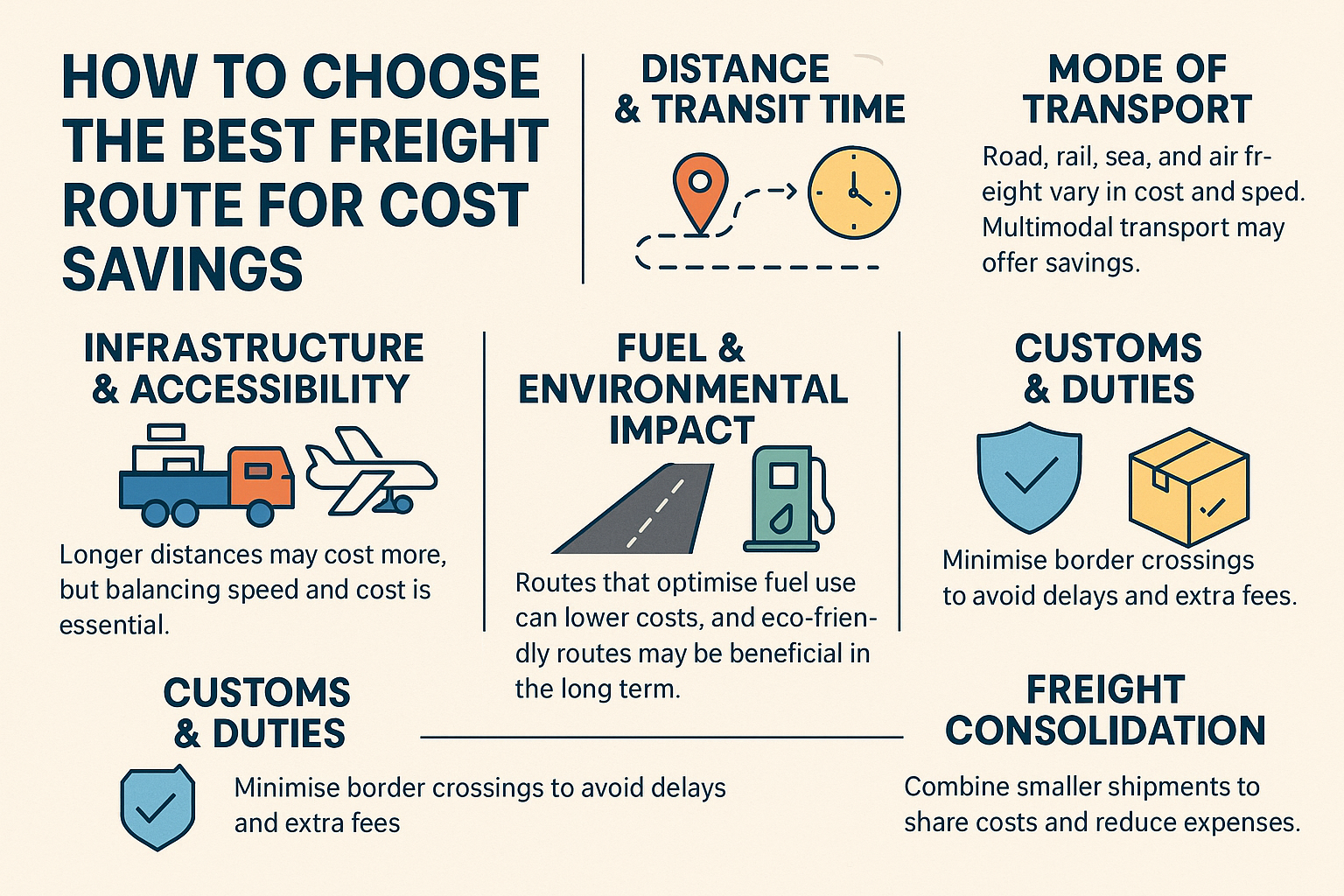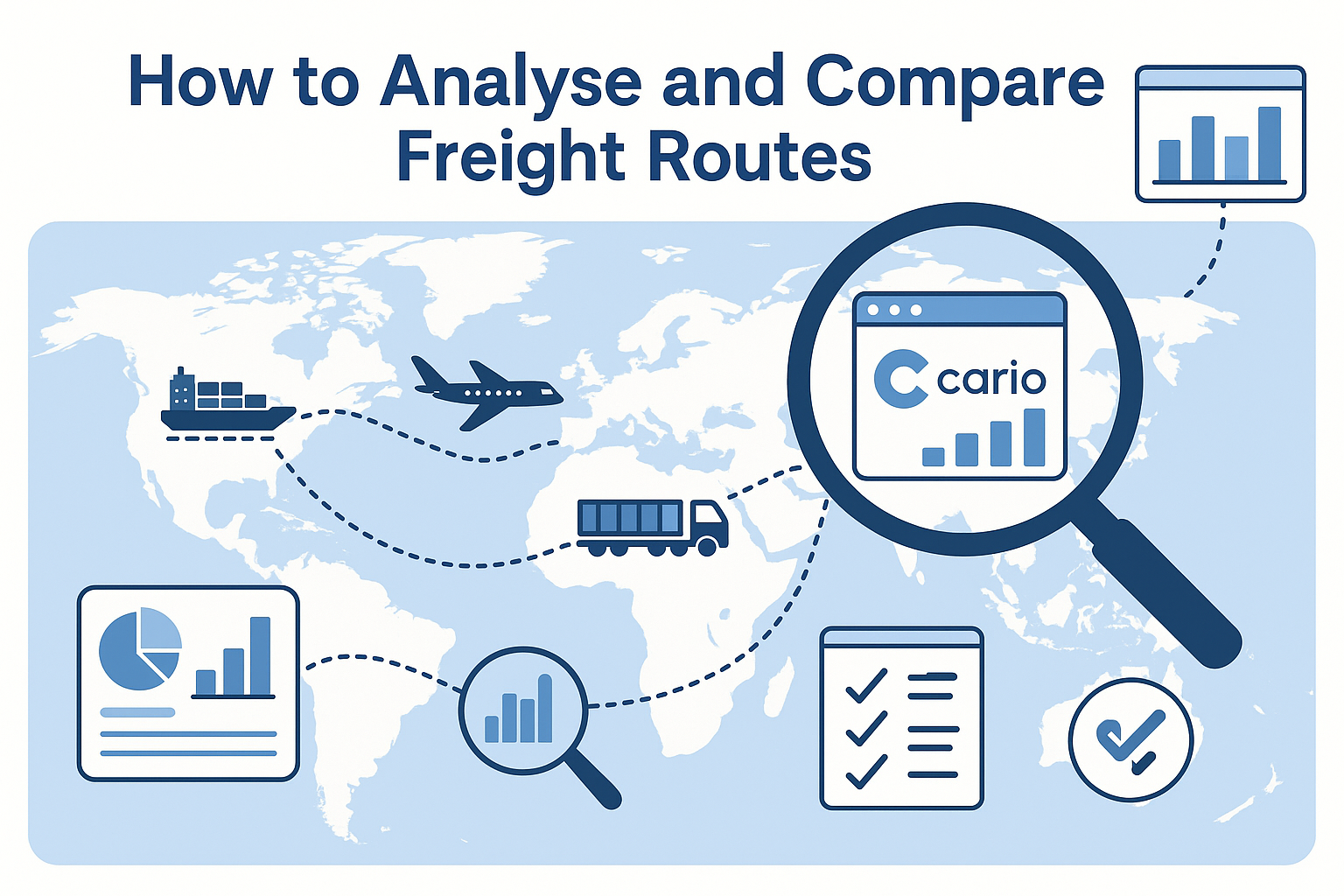
Cost savings is one of the most important factors in freight management. Companies across the globe are constantly seeking ways to minimise their logistics expenses, especially when shipping large volumes of goods.
One effective way to achieve this is by selecting the best freight route. Whether you're shipping locally or internationally, choosing the right route can significantly impact your overall freight costs.
In this article, we’ll explore how to choose the best freight route for cost savings, looking at the key factors you should consider, along with tips and strategies to make smarter freight decisions.
Let's Get Straight To The Point
Choosing the right freight route can significantly reduce shipping costs. Key factors to consider include:
Distance & Transit Time: Longer distances may cost more, but balancing speed and cost is essential.
Mode of Transport: Road, rail, sea, and air freight vary in cost and speed. Multimodal transport may offer savings.
Infrastructure & Accessibility: Well-maintained routes can reduce delays and costs.
Fuel & Environmental Impact: Routes that optimise fuel use can lower costs, and eco-friendly routes may be beneficial in the long term.
Customs & Duties: Minimise border crossings to avoid delays and extra fees.
Freight Consolidation: Combine smaller shipments to share costs and reduce expenses.
Use route optimisation software, collaborate with logistics experts, track routes regularly, and get quotes from multiple providers to make informed decisions. Additionally, seasonal fluctuations, freight class, and efficient packaging should be considered to reduce costs further. Optimising the entire shipping process, not just the route, will lead to significant savings.

Why Freight Route Selection Matters for Cost Savings
Freight costs are often a substantial portion of a company’s overall expenses, especially for those in the e-commerce, manufacturing, or retail sectors. Every decision, from the type of transport to the route taken, can affect the total cost of shipment. When you opt for a less-than-ideal route, you might end up spending more due to longer transit times, inefficient use of resources, or unexpected delays.
To reduce these costs, choosing the best freight route is essential. By carefully analysing your options, you can optimise your logistics and achieve considerable savings.
Factors to Consider When Choosing a Freight Route
1. Distance And Transit Time
The first factor to consider is the distance between the origin and destination. While it may seem obvious, longer distances often translate into higher costs. However, distance is not the only consideration—transit time plays a crucial role as well.
Longer routes may take more time, which can result in higher fuel costs and extended labour hours. However, a faster route may cost more due to premium shipping fees. Balancing speed and cost is key to optimising your route choice.
2. Mode Of Transport
The mode of transport is another critical factor in selecting the best freight route. Different types of freight (e.g., road, rail, sea, air) come with different cost structures and constraints.
Road transport is often used for short-distance shipments and is flexible, but it can be more expensive over long distances.
Rail transport offers cost efficiency for large shipments but might not be available everywhere.
Sea freight is typically the most cost-effective for international shipping, especially for bulk goods, but it takes longer.
Air freight is the fastest but is usually the most expensive.
Choosing the right mode depends on the urgency, volume of goods, and cost requirements. In many cases, a combination of these modes—known as multimodal transport—can provide cost savings without compromising speed or reliability.
3. Route Infrastructure And Accessibility
Not all routes are created equal. Some may have better infrastructure, such as highways, railroads, or ports, which makes transportation smoother and more affordable. Conversely, some routes may involve less-developed areas, where infrastructure limitations may result in delays, additional costs, and even damages to your goods.
When selecting a freight route, evaluate the infrastructure and accessibility of the route. Consider factors like:
The quality of roads, railways, or ports along the route
The availability of warehousing or distribution centres
Potential bottlenecks or traffic congestion points
Choosing well-maintained routes with fewer obstacles can help reduce transit delays, lowering your overall freight costs.
4. Fuel And Environmental Considerations
Fuel costs are one of the largest components of freight expenses, especially when dealing with long distances. While fuel prices fluctuate, selecting routes that optimise fuel consumption can reduce overall costs.
Additionally, environmental considerations are becoming increasingly important. Many companies are seeking to reduce their carbon footprint, and taking routes that minimise fuel usage and reduce emissions can contribute to cost savings in the long run, especially if sustainability is a priority for your brand.
5. Customs, Duties, And Border Crossings
If your freight needs to cross borders, customs and import/export duties can add to your costs. Certain routes may require passing through multiple countries, each with its own customs regulations and border checks. These factors can lead to additional fees and longer wait times at customs.
To avoid unnecessary delays and additional charges, it's important to choose freight routes that minimise border crossings or utilise efficient customs clearance procedures. Make sure you're aware of any international shipping regulations and work with a freight forwarding company that can help streamline the process.
6. Freight Consolidation Options
If your shipment isn't large enough to fill an entire container or truck, you can save money by opting for freight consolidation. This involves combining multiple smaller shipments into a single load and sharing the costs among different shippers. When choosing a route, look for options that allow you to consolidate freight efficiently.
Routes that support consolidation tend to offer lower rates because you're sharing the shipping space and costs with other businesses. This can result in significant cost savings, particularly for small to medium-sized businesses.
How to Analyse and Compare Freight Routes

Once you have a solid understanding of the factors affecting freight costs, you need to start analysing and comparing different routes. Here are some steps to help you make an informed decision:
1. Use Route Optimisation Software
Investing in freight route optimisation tools can help you analyse various routes based on key factors such as distance, cost, and transit time. These software tools can automatically calculate the most efficient routes based on the parameters you input, helping you find the best combination of cost savings and delivery speed.
2. Collaborate With Freight Experts
Freight people—experts in logistics and shipping—can offer valuable insights into the most cost-effective routes. Whether you're working with a freight broker or logistics consultant, these professionals can help you navigate complex shipping decisions. They are often familiar with specific routes, tariffs, and customs regulations that can save you time and money.
3. Monitor And Track Routes Regularly
Freight routes and costs can change over time due to factors such as weather conditions, infrastructure upgrades, or shifts in fuel prices. Regularly monitoring and tracking your selected routes will help you identify changes that might affect your freight costs. Use freight tracking systems to stay updated on real-time data and make adjustments to your routes as necessary.
4. Evaluate Freight Quotes From Multiple Providers
When choosing a route, it’s important to get quotes from multiple freight service providers. Each company may have different pricing structures or offer additional services that could influence the total cost. By comparing multiple quotes, you can choose a provider that best aligns with your budget and needs.
5. Understand Seasonal Fluctuations
Freight prices can vary by season. Peak shipping periods, such as during holidays or special events, tend to drive prices up due to increased demand. To save on costs, plan your shipments around these peak periods and adjust your route selection accordingly.
Best Practices for Reducing Freight Costs
1. Choose The Right Freight Class
Freight costs often depend on the freight class of your goods. Freight class is a system used to categorise goods based on their density, weight, and handling requirements. By selecting the appropriate freight class, you can avoid overpaying for shipments that require more specialised handling.
2. Bundle Shipments When Possible
If you have multiple shipments to send to the same destination, consider bundling them together on the same route. This can help you reduce costs by taking advantage of volume discounts or economies of scale.
3. Optimise Packaging
Efficient packaging can reduce the size and weight of your shipment, leading to lower freight charges. Work with your suppliers or logistics partners to ensure that products are packaged efficiently and appropriately for the route you’ve chosen.
4. Use Smart Routing For LTL Shipments
If you’re shipping less-than-truckload (LTL) shipments, look for smart routing options that minimise backtracking and empty miles. LTL shipments often involve multiple stops, so choosing routes that efficiently connect multiple deliveries can save money.
Conclusion
Choosing the best freight route for cost savings requires careful consideration of a variety of factors, from distance and transit time to mode of transport and customs procedures. By analysing these factors and utilising tools like route optimisation software and expert advice from freight people, you can find the most efficient, cost-effective routes for your shipments. Regularly monitoring your routes and adjusting your strategy will also ensure that your freight operations remain competitive and cost-efficient.
The key to reducing freight costs is not only choosing the cheapest route but also optimising every aspect of your shipping process. By balancing factors like speed, fuel consumption, and delivery time, you can significantly reduce your overall freight expenses while maintaining the reliability and efficiency that your customers expect.
FAQs
How Does Infrastructure Affect Freight Costs?
Routes with better infrastructure (e.g., highways, railways, ports) typically offer smoother and more cost-efficient transportation. Poorly developed routes may lead to delays, damages, or additional costs.
How Do Fuel Costs Influence Freight Route Decisions?
Fuel costs are a major part of freight expenses. Routes that minimise fuel consumption by optimising distance and avoiding congested areas can help lower shipping costs.
What Role Do Customs And Duties Play In Freight Costs?
Crossing borders often involves customs procedures and duties, which can add delays and extra fees. Minimising border crossings or selecting efficient routes with smoother customs processes can reduce these costs.
What Is Freight Consolidation, And How Can It Save Money?
Freight consolidation combines smaller shipments into one larger shipment, allowing businesses to share the shipping costs. This is especially beneficial for small to medium-sized shipments.
How Can I Compare Freight Routes To Find The Best Option?
Using route optimisation software, consulting with logistics experts, tracking routes regularly, and getting quotes from multiple freight providers can help identify the most cost-effective and efficient routes.

